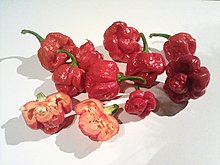| Trinidad Moruga scorpion | |
|---|---|
 | |
| Species | Capsicum chinense |
| Breeder | Wahid Ogeer |
| Origin | Moruga, Trinidad and Tobago |
| Heat | |
| Scoville scale | 1,207,764 average SHU |
The Trinidad Moruga scorpion (a cultivar of Capsicum chinense ) is a chili pepper native to the village of Moruga, Trinidad and Tobago. In 2012, New Mexico State University's Chile Pepper Institute identified the Trinidad Moruga scorpion as the hottest chili pepper at that time, with heat of 1.2 million Scoville heat units (SHUs). [1]
By 2017, according to Guinness World Records , the hottest pepper was the Carolina Reaper, with 1.6 million SHU. [2]

